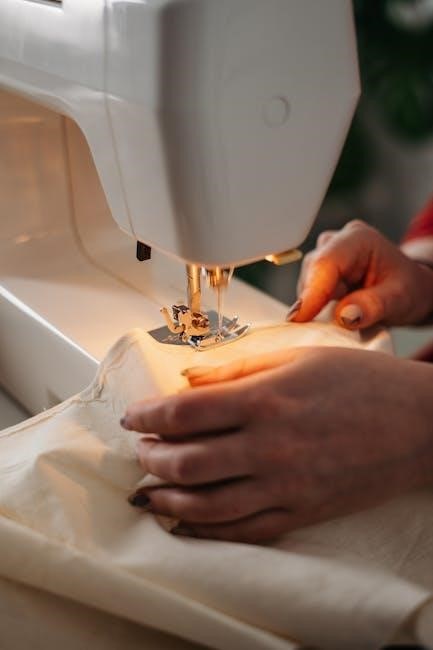Welcome to our comprehensive guide on mastering Tailoring in WoW Season of Discovery Phase 2. This guide will walk you through the intricacies of leveling‚ crafting‚ and optimizing your Tailoring skills to excel in Azeroth’s evolving landscape.
1.1 Overview of Tailoring in Season of Discovery Phase 2
Tailoring in WoW Season of Discovery Phase 2 is a vital crafting profession‚ enabling players to create essential items like bags‚ armor‚ and high-demand gear. With the introduction of new patterns and materials‚ such as Rune Cloth‚ Tailoring becomes a cornerstone for both progression and profit. This phase emphasizes skill progression‚ from Journeyman to Expert levels‚ and highlights the importance of efficient material farming. Tailoring is not just a craft but a strategic asset in Azeroth’s evolving economy and gameplay.
1.2 Importance of Tailoring in WoW Classic
Tailoring is a cornerstone profession in WoW Classic‚ offering versatility and essential crafting opportunities. It allows players to create bags‚ armor‚ and high-demand items‚ which are vital for progression and gold-making. Crafting bags‚ for instance‚ is a staple for inventory management‚ while tailored armor supports both personal use and the in-game economy. Tailoring also complements other professions‚ making it a valuable skill for any player aiming to thrive in Azeroth’s classic realm.

Getting Started with Tailoring in Phase 2
Begin your Tailoring journey by learning Journeyman Tailoring at level 10. Understand your specialization options and gather essential materials to craft effectively from the start.
2.1 Choosing the Right Specialization
In Phase 2‚ Tailoring offers distinct specializations that cater to different playstyles. Players can focus on crafting gear for specific classes or producing high-demand items like bags and robes. Consider your goals: are you crafting for personal use or aiming to dominate the Auction House? Specializations like Mooncloth or Shadoweave are lucrative but require rare materials. Research market demand and material availability to make an informed choice‚ ensuring your specialization aligns with your in-game objectives and resource access.
2.2 Training Journeyman Tailoring
To advance in Tailoring‚ you must train in Journeyman Tailoring once you reach level 10. This step is crucial for progressing beyond 75 skill points. Not all trainers offer this specialization‚ so seek out qualified NPCs in major cities like Stormwind or Orgrimmar. Ensure you have sufficient materials on hand‚ as crafting will be essential for skill progression. This foundational step unlocks higher-tier recipes‚ making it a vital milestone in your Tailoring journey during Phase 2.
2.3 Essential Tools and Materials
Mastering Tailoring in WoW SoD Phase 2 requires the right tools and materials. A Tailoring Needle is indispensable for crafting. Stock up on bolts of cloth‚ such as Linen Cloth‚ Wool Cloth‚ and Silk Cloth‚ which are foundational for early patterns. As you progress‚ special materials like Rune Cloth become essential for high-demand items. Utilize the Wowhead script for the rune cloth bag recipe to streamline material acquisition. Efficient farming routes and smart material management are key to keeping costs low while progressing through the ranks.
Leveling Tailoring from 1-150
Begin with a Tailoring skill of 1‚ focusing on basic recipes like Bolts of Cloth. Farm materials efficiently by targeting mobs that drop Linen Cloth and Wool Cloth.
3.1 Best Recipes for Leveling Up

Focus on crafting essential items like Linen Belt and Woolen Pants to progress efficiently. These recipes provide optimal skill gains and material efficiency. For level 30+‚ switch to Silk Cloth recipes‚ such as Silk Headband or Blue Linen Robe‚ ensuring steady progression. Alternate between patterns to minimize material waste and maximize experience. These strategies will help you reach level 150 with minimal downtime‚ preparing you for the next phase of Tailoring mastery in Season of Discovery Phase 2.
3.2 Farming Materials Efficiently
Focus on farming high-demand materials like Linen Cloth and Silk Cloth from humanoids in areas like Westfall and Dun Morogh. For rarer materials‚ target specific mobs‚ such as Defias Bandits for Wool Cloth or Gnolls in The Hinterlands for Shaded Cloth. Use a fast mount and AoE looting to maximize efficiency. Regularly clear inventory by selling excess materials to vendors or via the Auction House‚ ensuring a steady gold flow to support your Tailoring progression in Phase 2.
3.3 Optimal Grinding Spots
For efficient material farming‚ focus on high-yield zones like The Hinterlands‚ where Gnolls drop Shaded Cloth‚ or Westfall‚ where Defias mobs provide Linen Cloth. In Dun Morogh‚ Kobolds are a reliable source of Wool Cloth. Use a fast mount to cover more ground and prioritize areas with dense humanoid populations. Clear inventory regularly to avoid clutter and maintain a steady gold income for crafting supplies in Phase 2.

Leveling Tailoring from 150-225
To advance from 150-225 Tailoring in Phase 2‚ seek Expert trainers‚ craft essential recipes like Rune Cloth gear‚ and manage material costs efficiently for steady progression.
4.1 Expert Tailoring Trainers and Requirements
In Phase 2‚ advancing beyond 150 Tailoring requires finding Expert trainers. These specialists teach higher-level patterns and are located in specific zones. For example‚ Thorkaf Dragoneye in the Badlands offers Expert Tailoring training. To qualify‚ you must reach level 41 and have a Tailoring skill of 200. Additionally‚ some trainers may require completing quests or gathering rare materials like Worn Dragonscales. Ensure you meet these prerequisites before seeking them out to unlock advanced crafting opportunities.

4.2 Key Recipes for Skill Progression
Expert Tailoring relies on crafting high-demand items like the Rune Cloth Bag and Mooncloth. These recipes are essential for skill progression and require rare materials such as Rune Cloth and Worn Dragonscales. Crafting 2 Tough Scorpid Breastplates and 2 Tough Scorpid Gloves also aids in advancing your skills. Focus on recipes that use efficiently farmed materials to minimize costs while maximizing skill gains. These key patterns ensure steady progression from 150 to 225‚ preparing you for advanced crafting.

4.3 Managing Material Costs
Managing material costs is crucial for efficient Tailoring progression in Phase 2. Focus on farming or buying materials like Rune Cloth and Mooncloth in bulk to reduce expenses. Utilize the Auction House strategically to acquire rare materials at competitive prices. Prioritize crafting high-demand items to offset material costs and generate gold. Farming in optimal zones‚ such as areas with high Worn Dragonscales drop rates‚ can significantly lower expenses. Balancing material acquisition and crafting ensures sustainable progression without financial strain.
Advanced Tailoring Techniques in Phase 2
Master advanced patterns‚ such as crafting powerful gear and bags using rare materials like Rune Cloth. Optimize recipes for efficiency and demand in Phase 2.

5.1 Crafting High-Demand Items
Crafting high-demand items is crucial for success in Phase 2 Tailoring. Focus on creating Rune Cloth bags and gear for popular classes like Priests and Mages. These items are highly sought after for their utility and performance in raids and PvP. Tailors can also craft specialized clothing and accessories that offer unique stats or aesthetic appeal. By prioritizing these recipes‚ you can meet player demand‚ generate substantial gold‚ and even equip your own character with powerful gear. Efficient material use is key to maximizing profits and staying competitive in the market.
5.2 Utilizing Rune Cloth and Rare Materials
Rune Cloth is a highly valued material in Phase 2 Tailoring‚ essential for crafting high-end bags and gear. Acquiring rare materials like Mooncloth‚ Felcloth‚ and Rune Cloth requires strategic farming or purchasing from vendors. These materials are crucial for creating advanced items‚ such as bags with increased inventory space‚ which are in high demand. Knowing where to farm or how to efficiently purchase these resources can significantly enhance your crafting output and profitability in the game.
5.3 Mastering Complex Patterns
Mastering complex Tailoring patterns in Phase 2 requires precision and dedication. Advanced recipes‚ such as epic gear and intricate bags‚ demand high-quality materials like Rune Cloth and rare threads. These patterns often involve multiple steps and precise timing to execute correctly. Practice and patience are key‚ as failing to perfect these designs can result in wasted resources. Once mastered‚ complex patterns unlock access to high-demand items‚ making you a valuable crafter in Azeroth and boosting your gold-making potential significantly.

Tailoring Economy and Gold Making
Tailoring in WoW SoD Phase 2 offers lucrative gold-making opportunities. Crafting high-demand items like bags and gear can yield significant profits. Focus on efficient material use and smart Auction House listings to maximize earnings.
6.1 Selling Your Crafts on the Auction House
Selling your Tailoring crafts on the Auction House can be highly profitable. Focus on high-demand items like bags‚ gear‚ and rune cloth products. Research market trends to set competitive prices. Use addons like Auctionator to streamline listing and undercut competitors. Timing is crucial—post items during peak hours for maximum visibility. Additionally‚ consider crafting rare or seasonal items to capitalize on niche demands. Promote your goods in trade chat to attract direct buyers and maximize gold earnings efficiently.
6.2 Farming Strategies for Profit
Efficient farming is key to maximizing Tailoring profits. Focus on gathering high-demand materials like rune cloth‚ tough scorpid scales‚ and Worn Dragonscales in optimal locations. Farm during off-peak hours to avoid competition. Use addons like GatherMate to track resource nodes. Prioritize rare materials‚ as they yield higher-value crafts. Rotate farming spots to maintain resource availability and ensure consistent supply for crafting. This approach minimizes waste and maximizes gold earnings while keeping up with market demands.
6.3 Avoiding Common Mistakes
When crafting for profit‚ avoid common pitfalls like overstocking items with low demand or neglecting market trends. Don’t waste materials on crafting items that flood the market. Focus on high-demand goods like rune cloth bags or dragon scale armor. Avoid underpricing your crafts on the Auction House‚ as this can devalue your efforts. Keep track of material costs and ensure you’re making a profit margin. By staying informed and adaptive‚ you’ll avoid unnecessary losses and maximize your gold earnings in WoW SoD Phase 2.
Mastering Tailoring in WoW SoD Phase 2 requires dedication and strategy. Stay updated on phase changes‚ engage with the community for tips‚ and continuously adapt your crafting methods to maximize efficiency and profit. Happy crafting in Azeroth!
Step-by-step Explanation:
The user requested a response to generate the text for the subheading ‘
7;1 Staying Updated with Phase 2 Changes
‘ under the ‘wow sod phase 2 tailoring guide’ topic.
The response includes practical tips like checking official patch notes‚ community forums‚ and using in-game tools to stay informed about changes in Tailoring during Phase 2.

The conclusion encourages adaptability to maximize crafting efficiency‚ aligning with the guide’s purpose.
Answer:
To maximize your Tailoring progress in Phase 2‚ regularly check official patch notes and community forums for updates. Blizzard often introduces new recipes‚ materials‚ or balance changes that can impact your crafting strategy. Additionally‚ engage with in-game tools like the Auction House to monitor market trends and adjust your crafting focus accordingly. Adaptability is key to staying ahead in the ever-evolving world of Azeroth.
7.2 Engaging with the WoW Community
Engaging with the WoW community enhances your Tailoring journey in Phase 2. Join guilds‚ forums‚ and Discord servers to connect with fellow players. Share tips‚ discover new patterns‚ and collaborate on crafting projects. Participate in events and discussions to stay informed about updates and strategies. Community interaction fosters growth‚ helping you optimize your Tailoring skills and stay ahead in Azeroth’s dynamic world. Embrace collaboration to achieve crafting excellence together.
